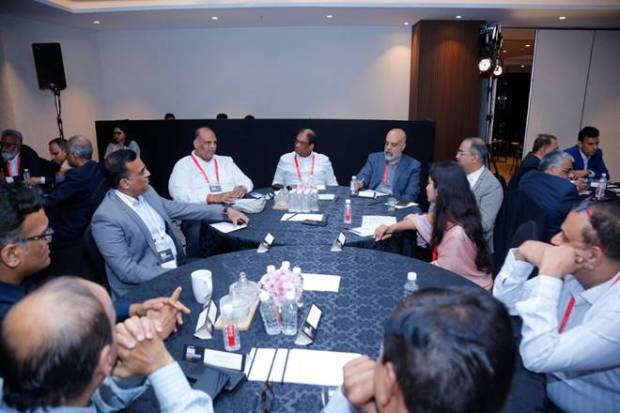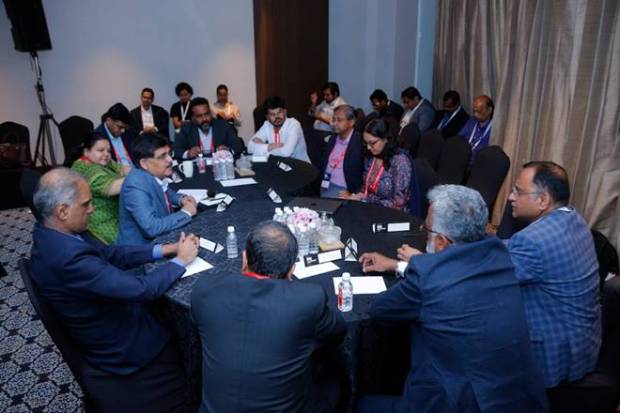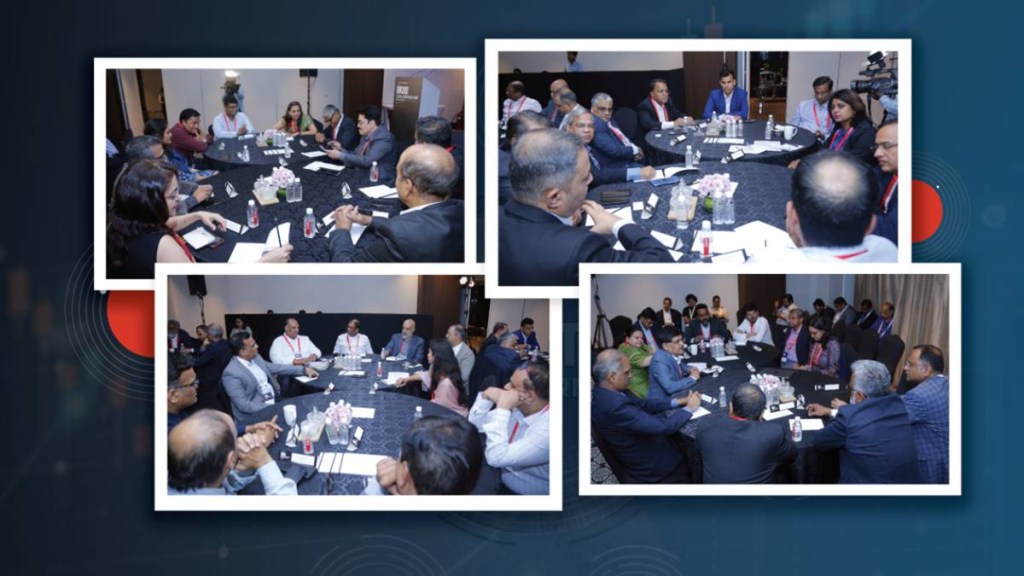FE Connect
The FE CXO Leadership Dialogue held in partnership with Oracle saw a confluence of some of the finest minds and genuine practitioners share insights. What the CXOs across sectors were reading in the changing landscape with respect to adoption of Gen AI was crucial in the light of the emerging opportunities and the challenges on the road ahead. The focus of their attention was on the tech hacks that could be transformational for businesses and where it could prove crucial while investing for growth. The other area discussed was a topic that was increasingly engaging their attention. It was around ways to leverage GenAI in matters concerning ESG (Environmental, Social and Governance). Where they were in the journey with regulatory compliance on this gaining importance as also the gains to be accrued as an organisation get to have each of its root and branch think green.

Investing for growth: The key tech hacks that can transform your company
The speakers at the table discussed key tech hacks that could lead to future business transformations and the long-term value creation. As per a report by Deloitte, the average tech budget as a percentage of revenue was 5.49 per cent in 2022, up from 4.25 per cent in 2020. This was expected to increase to 5.85 per cent by 2024. While for few speakers, it made sense to invest 2 per cent of the overall revenue on tech integrations, for others, it was 5-10 per cent of the overall revenue that ought to be the goal. However, most maintained that much depended on the nature of the business. For instance, if it could be a tech-facing company and as food services aggregator that needed a front-facing digital application, or it could be a client-facing company which was not completely dependent on technology or offering tech-based solutions/ services.

While maintaining that technology should help in augmenting the revenue, the speakers felt there were some key metrics specific to different sectors that helped organisations take decisions on tech investments translating into tangible business value. These metrics included data analytics and business intelligence, identifying strength and weakness and areas of improvement in an organization, the need for modernising legacy systems, calculation of ROI and the risks involved.
One approach to evaluate the need for technology and to evaluate on the kind of investments needed on technology was making ‘reference architecture.’ It being to guide a company on where it needed to spend (in terms of technology).
Buying decisions, the speakers felt, were made very conservatively with deep evaluation of previous spends, ROI on previous spends and based on the future vision. The speakers also discussed the feasibility of creating in-house tech stacks / tech products instead of outsourcing it.
Use of Generational AI in helping meet ESG goals.
The speakers here looked at the centrality of data, the importance of data quality with a clarity on what the technology was trying to address. For instance, was the net goal, risk aversion, compliance or commercial benefit? Answer to this question, they felt, could hold material significance to the company seeking to leverage the technology. GenAI, it was largely felt, could be a huge enabler in ensuring well-informed decision-making. While there were many tools available, their integration could make life a lot easier for the practitioners, constantly in need of “useful intelligence.” A point emphasised by many was the importance of getting the right data and sensitising those who need to input the data on what was needed, especially when seen from the context of Environmental, Social and Governance (ESG) perspective. One of the aspects that was felt crucial about ESG data was the need to set your boundaries correctly. The extent to which the wings were to be spread to achieve stated goals, the data to be gathered and the timeframe in which it needed to be collected.
The scale and speed at which the information was churned out and the analytics readied for decision-making were not to miss the aspect of getting the right set of data – both in terms of quality and quantity. For, without this, it would be the proverbial ‘garbage in and garbage out.’ Linked to it was the importance of sensitising the people entering the data.
Imperative for this was the need to think not just about the right technology but also the process by which information was collected. This, while also eliminating manual intervention and replacing it with automated data collection methods to ensure right input and output. With these in place, the use of AI, it was felt, could be much more meaningful.
What added richness to the discussion was the fact that the speakers spanned across sectors ranging from manufacturing in factories to financial inclusion. In the case of latter for instance, there were strict data privacy guidelines that had to be adhered to. However, data analytics could be leveraged to enable expansion of business in a particular geography.
While discussing the intersection of technology and the ESG, there were several lenses through which things could be viewed. One was about reporting and disclosures versus performance and operations. This was when technology was needed for disclosures and technology while also for operations and performance. Then, there was the aspect of stakeholder view – what was required for customers, employees.
Eventually, organisations would gravitate to what was more material and strategic to them and thereby address the issue of which technology was crucial.
Certain technologies were already tried and tested like cloud for instance, while, few others like AI and GenAI were emerging technologies.
What was interesting to most was that because of the overarching movement from voluntary to regulatory mandates on reporting, say through the BRSR (Business Responsibility and Sustainability Reporting) in India, there was an exponential scaling up of reporting in terms of volumes and in the type of qualitative and quantitative data. This posed both challenges and opportunities for companies as well as for the rating agencies. Today, a typical disclosure report would run into over 100 pages. Gen AI for instance, could play a very important role in sifting through this and generating useful intelligence for rating entities and for the government agencies also.
On the pain points, the view was that there were a variety of frameworks with the expectations from each rather different. Lot of rating agencies were guided by their own weightages – for example, there was a difference in the weightages given to the environmental, social and governance aspects in ESG and that was one pain point that many corporates seem to share.
The second pain point was around the set of questions being asked in each of the areas. While the questions were somewhat similar, the indicators were different. The hope here was that if there was a tool that had all the basic information on the indicators that were common across all the frameworks, the system should be able to automatically pool in the information and bring out the report.
There were three parts to the data collection process – empower meaning defining the boundary, taking into consideration end-to-end benchmarking and making sure everyone in the organisation understood his or her role in terms of providing the inputs.
Second aspect was around the need to “embrace,” wherein a tool was already there along with a method whereby all got to punch-in all the data.
Third was around trying to “elevate” the game, as it were – and this was where the power of AI sat. Here, what was needed was building predictive and also transformative analytics so one could showcase the trajectory of the organisational carbon footprint and how that was moving and then also look at how the organisation’s supplier and dealership footprint was operating and how the risk profile looked for the organisation from the ESG point of view.
How to use the report and analyse it was where Gen AI was helpful as also in defining the boundaries, trajectories, educating better on the pace of the journey to the goal.
All agreed that the concept of ESG was still new in India. As a starting point in the ESG journey would be to look at the compliance part – the BRSR requirement. It would also give a broad perimeter on the nature of data needed. Once that has been attained in the most accurate manner possible with clean data, the next step would be to look at the strategic goals and the business insights that could be derived.
Also, insights varied depending on the industry. For example, those in the services industry would be more inclined towards diversity, inclusion, and people policies. These would need insights on the age group of talent or on the aspect of gender. Then, the next stage was around setting goals, planning and tracking it. Be it around turning carbon neutral, hiring more women in senior roles, and then start comparing the current state and the status and to extent to which the journey was on course and what more was needed to be done.
Technology provided a good framework and data would get standardised, it would also help prevent greenwashing, the biggest risk in ESG reporting. Predictive analysis would also help contain this.
At the end of the day, usefulness of technology lay in its ability to help make a good decision. The end goal, it was felt across the board, should be ‘useful intelligence.’
Ultimately, each organisation and its teams needed to get to a stage where they focussed on their core competency or on their respective domains while letting the technology do the rest of it.
For more information on Oracle please contact- https://www.oracle.com/in/corporate/contact
Participants at the FE CXO Leadership Dialogue
| Aashish Muttreja | Solutions Engineering Director – CX Marketing, India | Oracle |
| Ajay Jindal | Chief Financial Officer | BPL Medical Technologies pvt ltd |
| Akilur Rahman | Chief Technology Officer | Hitachi Energy India |
| Amit Gupta | Head, IT and Digital Transformation | Quest Global |
| Amit Kumbhat | Director – IT | Four Seasons Hotel Bengaluru |
| Amiya Tripathy | Chief Financial Officer | Tata Insights And Quants |
| Anand Ramaswamy | General Manager | Quest Global |
| Anirban Chakraborti | SVP- Product & Business | Sangeetha Mobiles |
| Anup Anand | Senior Director, Corporate Financial Accounting | Hewlett Packard Enterprise |
| Arvind Singh | Chief Technology Officer | Puravankara Group |
| Bipasha Banerjea | Finance Transformation Officer | United Breweries Limited |
| Bittu Varghese | Chief Financial Officer | Table Space |
| Devi Choudhury | Associate Director | Carelon Global Solutions |
| Devraj Sanyal | Chief Technology Officer | Dono Consulting Private Limited |
| Dinesh Narayan | Global Chief Information Officer | TVS Supply Chain Solutions |
| Gajapathy Namasivayam | Chief Information Officer | V G Solution & Services Private Limited |
| Gautham Anand | Senior Leader Finance Transformation | Thomson Reuters |
| Harish Maheshwari | Director, Finance Transformation and Analytics | Thomson Reuters |
| Hegde Subbarao | Director | dFarm Inc |
| Himanshu Munot | Associate Director, Finance | Carlon Global Solutions India LLP |
| Jagadamba B | Vice President Talent Acquisition | Perfios |
| Janardhanan N | Chief Human Resources Officer | Stovekraft Limited |
| Jayasanckar R | Vice President and Head -EHS | EID Parry (India) Limited |
| Kishore S M | Group Chief Finance Officer | Grab Geezy Private Limited |
| Kumar Arunachala | Chief Technology Officer | VTARA Energy Group |
| Madhukar Uniyal | Head – Solution Engineering | Oracle Applications |
| Maqsood Pasha | Global IT Head | Ephicacy Lifescience Analytics |
| Narayan PS | Global Head – Sustainability and Social Initiatives | Wipro Limited |
| Naveen Kalappa | Global Practice Head – Embedded and Electronics | Tata Technologies |
| Naveen Kumar | Senior Finance Manager | Carelon Global Solutions |
| Naveen TN | Chief Technology Officer | Phoenix Systems Group |
| Neha Jain | Principal Solution Engineer | Oracle |
| NLS Murthy | General Manager & Country Leader | Greenway Health India Pvt Ltd |
| Prashanth BA | Manager Data and Analytics | Thomson Reuters |
| Praveer Surana | Chief Finance Officer | Atyati Technologies Private Limited |
| Raja Nagendra Kumar | Chief Technology Officer | Tejasoft Innovations Private Limited |
| Rajganesh Ramachandran | Chief Financial Officer | Adecco |
| Rakesh Sharma | Director Solution Engineering | Oracle |
| Ram | CIO | Systemantics India Pvt. Ltd. |
| Ramya Suresh | Principal Solution Consultant – EPM | Oracle |
| Ravi Anantharamiah | Global Controller | Wipro Enterprises |
| Sachin Gupta | Chief Information Officer | Amagi corporation |
| Sandeep Bardia | Chief Financial Officer | Cloudnine Group of Hospitals (Kids Clinic India Ltd) |
| Sandhya J | Chief Financial Officer | Narayana Health |
| Srinivasa Raghavan | Finance Advisor | HCG |
| Sriram Santhanam | Director-Finance & Company Secretary | Flowserve India Controls Pvt Ltd |
| Sunil Wahi | Head of Applications Solution Engineering, Japan and Asia Pacific | Oracle |
| Sunila Sahasrabudhe | Head ESG | Biocon Limited |
| Thakur Pherwani | Chief Sustainability Officer | TVS Motor Company |
| Uday Prakash | VP, Finance & Operations | Herbalife India |
| Utham BV | Asst Manager – Finance | Carelon |
| Vasudev Prabhu | Director – IT & Resiliency | Cognizant Technology Solutions Limited |
| Vikram Sharma | Vice President – HR | Strides Pharma Science Limited |
| Vishwanath Gouda | Manager Finance | Carelon Global solutions |
| Yash Sharma | Founder and CEO | Go Rewise |

